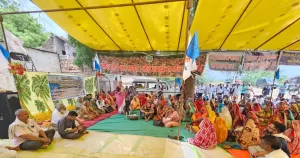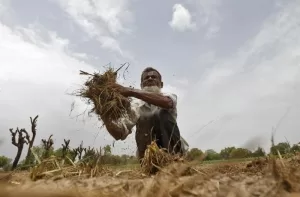The Norwegian Nobel Committee has awarded this year’s Nobel Peace Prize to the United Nations World Food Programme, declaring that it wanted “to turn the eyes of the world toward the millions of people who suffer from or face the threat of hunger.” Those numbers are now greater than ever – and the dysfunctional global food system is largely to blame.
Even before the COVID-19 pandemic struck, around two billion people globally were experiencing food insecurity, and close to 750 million faced chronic or severe hunger. The health and economic crises that erupted in 2020 have made matters much worse, partly because of their impact on food supplies, but even more so because of increasing inequality and the loss of livelihoods among already vulnerable people.
This situation was, and is, preventable. The UN’s Sustainable Development Goals (SDGs) include the eradication of hunger by 2030. This goal – SDG2 – is genuinely attainable: the world already produces enough food to meet the basic nutritional requirements of everyone on the planet. But the global food system was badly broken well before the pandemic. Much food production is unsustainable. Both food and monetary incomes are so unequally distributed that billions of people cannot afford a healthy and balanced diet. And global food corporations have skewed both production and distribution to the detriment of small farmers and final consumers.
Inequalities in food access are evident across and within countries, even as irrationalities abound in food supply chains. All too often, a region’s raw products are shipped around the world to be processed with chemical preservatives, and then transported back for consumption in or near their place of origin.
One reason why the world is currently not on track to achieve SDG2 is because policymakers have misdiagnosed the problem. Instead of emphasizing sustainable (and more local and diversified) food production and equitable distribution, they have focused on increasing agricultural productivity and making supply chains more “efficient” by reducing costs. That has led to an overemphasis on yields, insufficient attention to agro-ecological contexts and local nutritional requirements, and strong incentives for chemical-based agriculture.
This approach is exemplified by the Alliance for a Green Revolution in Africa (AGRA), an initiative launched in 2006 by the Bill & Melinda Gates Foundation and the Rockefeller Foundation. AGRA’s programs support the use of high-yielding commercial seeds, synthetic fertilizers, and chemical pesticides in a monocropping model to increase yields per acre. Surprisingly, advocates of this approach seem largely unaware that similar projects in many Asian developing countries previously produced medium-term results that were mixed at best and were often associated with major ecological problems.
AGRA initially aimed to double the household incomes of 20 million small-scale African farmers by 2020, and halve food insecurity in 20 countries through productivity improvements. It then adopted the more ambitious targets of doubling yields and incomes for 30 million farming households by 2020. But with the deadline approaching, AGRA has shifted the goalposts, and is now promising, much more modestly, to increase incomes (by an unspecified amount) and improve food security for 30 million smallholder farm households in 11 African countries by 2021. In a recent response to criticism, AGRA was even more circumspect, claiming that its goal is to reach only nine million farmers directly and the remaining 21 million indirectly (though what that means is not clear).
Despite scaling back its targets, AGRA has not provided data regarding its progress so far. So, there are no reliable estimates of the increase in farmers’ yields, net incomes, and food security. But independent researchers reached some disturbing conclusions in a recent study that used national-level data on production, yields, and harvested areas for the most important food crops in AGRA’s 13 main target countries. The report found scant evidence of significant increases in small producers’ incomes or food security; instead, it concluded that the number of hungry people in AGRA countries had increased by 30%. (AGRA calls this analysis “deeply flawed,” but has not provided data to counter it.)
Regarding productivity, the study found that yields of staple crops in AGRA countries increased by only 1.5% per year on average in the first 12 years of the organization’s operations – virtually the same rate as in the 12 years prior to its founding. Productivity growth declined in eight of the 13 countries; in three countries, yields actually fell. Even in countries where staple-food production increased substantially – such as Zambia, where maize output more than doubled, owing mainly to an increase in sown area – poverty and hunger among small producers remained very high.
Moreover, the report showed how the adverse outcomes associated with Green Revolution practices elsewhere were also evident in AGRA countries. Land use shifted away from more nutritious and climate-resilient traditional crops like sorghum and millet toward “high-yielding” maize that required farmers to buy more expensive seeds, often causing indebtedness. Monoculture and heavy use of chemicals (such as petroleum-based fertilizers) led to soil acidification and other ecological problems affecting future cultivation. Monoculture has also made diets less diversified and nutritious by reducing production of staple root crops like cassava and sweet potato.
As Jomo Kwame Sundaram has argued, such Green Revolution programs are fundamentally flawed because they view nutrition only in terms of total calorie consumption, and fail to recognize the superior nutritional value of a diverse diet. The latter requires a variety of crops best suited to the location and climate. But the headlong rush to promote supposedly “new” practices rules this out.
The pandemic and ongoing climate change should have taught us the importance of building resilience. Unfortunately, well-intentioned efforts to improve food security in Africa and elsewhere are instead increasing small farmers’ dependence on global agribusinesses without raising their incomes, and making farming systems more fragile and less resilient.
(Jayati Ghosh is Executive Secretary of International Development Economics Associates and a member of the Independent Commission for the Reform of International Corporate Taxation. Article courtesy: Project Syndicate, a website devoted to commentaries on occurrences around the world.)




